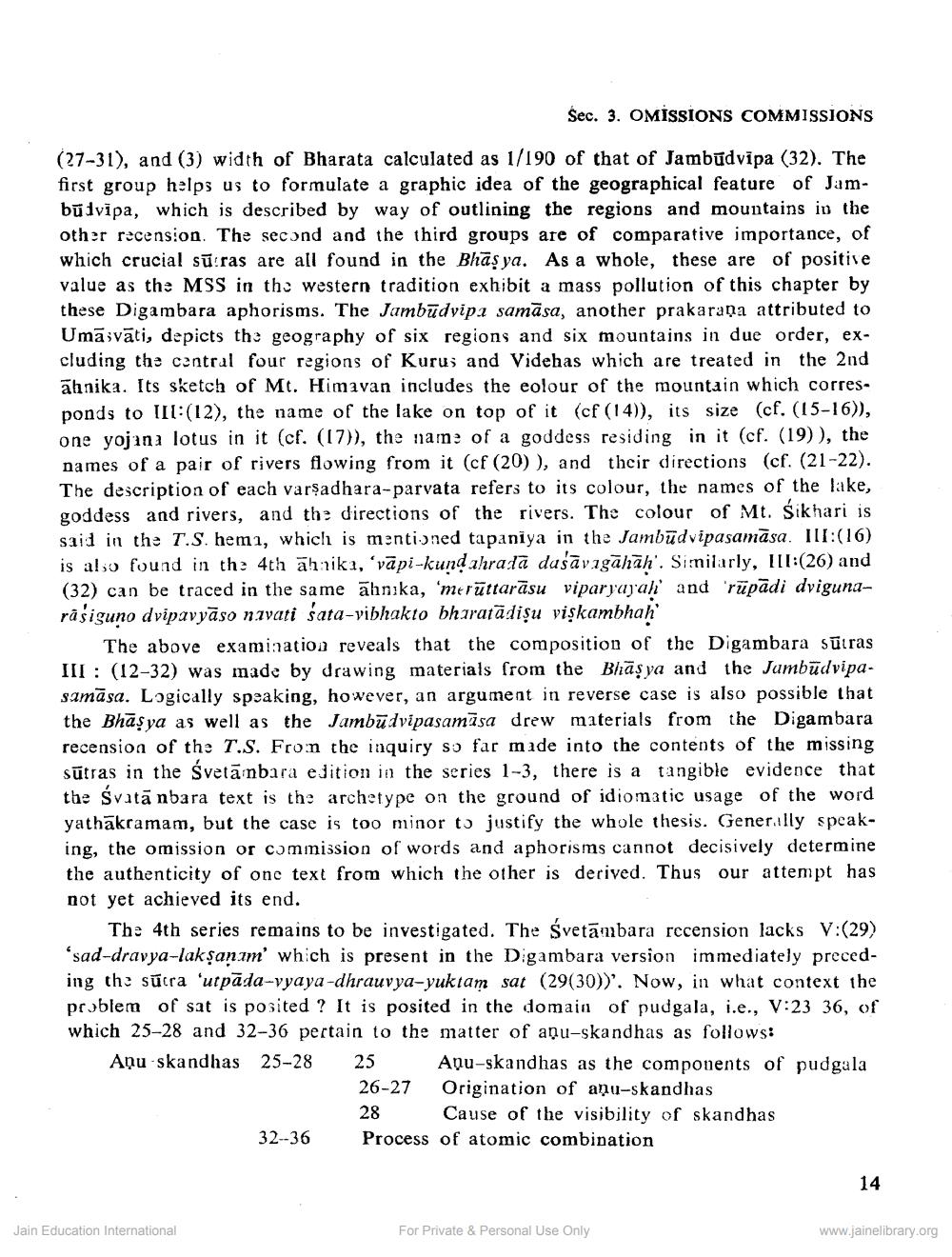________________
Sec. 3. OMISSIONS COMMISSIONS
(27-31), and (3) width of Bharata calculated as 1/190 of that of Jambudvipa (32). The first group helps us to formulate a graphic idea of the geographical feature of Jambudvipa, which is described by way of outlining the regions and mountains in the other recension. The second and the third groups are of comparative importance, of which crucial sü:ras are all found in the Bhasya. As a whole, these are of positive. value as the MSS in the western tradition exhibit a mass pollution of this chapter by these Digambara aphorisms. The Jambudvipa samāsa, another prakarapa attributed to Umāvāti, depicts the geography of six regions and six mountains in due order, excluding the central four regions of Kurus and Videhas which are treated in the 2nd ahnika. Its sketch of Mt. Himavan includes the colour of the mountain which corresponds to (12), the name of the lake on top of it (cf (14)), its size (cf. (15-16)), one yojana lotus in it (cf. (17)), the name of a goddess residing in it (cf. (19)), the names of a pair of rivers flowing from it (cf (20)), and their directions (cf. (21-22). The description of each varsadhara-parvata refers to its colour, the names of the lake, goddess and rivers, and the directions of the rivers. The colour of Mt. Sikhari is said in the T.S. hema, which is mentioned tapaniya in the Jambudvipasamāsa. III:(16) is also found in the 4th ähnika, vapi-kundahrata dasavagahah. Similarly, III:(26) and (32) can be traced in the same ähnika, merüttarasu viparyayal and rupadi dvigunarasiguno dvipavyäso navati sata-vibhakto bharatädişu viskambhah
The above examination reveals that the composition of the Digambara sutras III (12-32) was made by drawing materials from the Bhasya and the Jambudvipasamasa. Logically speaking, however, an argument in reverse case is also possible that the Bhasya as well as the Jambudvipasamasa drew materials from the Digambara recension of the T.S. From the inquiry so far made into the contents of the missing sutras in the Svetanbara edition in the series 1-3, there is a tangible evidence that the śvata nbara text is the archetype on the ground of idiomatic usage of the word yathakramam, but the case is too minor to justify the whole thesis. Generally speaking, the omission or commission of words and aphorisms cannot decisively determine the authenticity of one text from which the other is derived. Thus our attempt has not yet achieved its end.
The 4th series remains to be investigated. The Svetambara recension lacks V:(29) 'sad-dravya-lakṣaṇam' which is present in the Digambara version immediately preceding the sutra 'utpada-vyaya-dhrauvya-yuktam sat (29(30)). Now, in what context the problem of sat is posited? It is posited in the domain of pudgala, i.e., V:23 36, of which 25-28 and 32-36 pertain to the matter of apu-skandhas as follows:
Apu skandhas
25-28
25 26-27 28
Jain Education International
32-36
Apu-skandhas as the components of pudgala Origination of apu-skandhas
Cause of the visibility of skandhas. Process of atomic combination
For Private & Personal Use Only
14
www.jainelibrary.org




